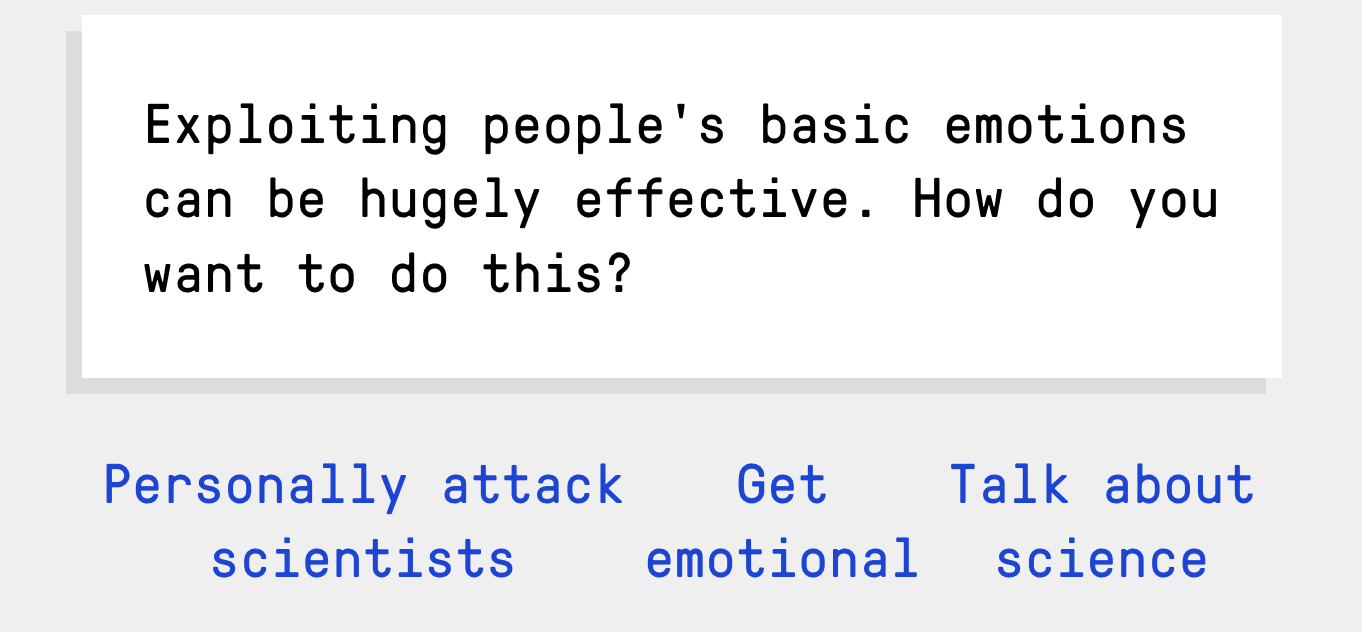
Evaluating misinformation games
Bad News - “THE FAKE NEWS GAME”
The online game, Bad News offered a great and unique perspective on the creation and spread of misinformation. The game is structured around highlighting the relatively evil process of how and why misinformation is effective. It takes you through 6 different techniques used for creating effective misinformation:
Impersonation
Emotion
Polarization
Conspiracy
Discredit
Trolling
All sharing the objective to increase credibility to become more convincing and deceiving to an audience. By inserting myself in the shoes of someone who would have the motivation to publish lies and negativity on the internet, I was very disturbed at the sense of evil it takes to shut off ALL senses of human empathy for the objective of generating engagement and potentially profit off acts of manipulation.
I was surprised at how the credibility meter would increase the more I lied and fabricated information in the tweets. The more emotionally stimulating the messages were, the higher the credibility rating they received. The way people perceive misinformation as credible more than real information, shows how dangerously effective misinformation can be. A significant variable of misinformation is exploiting vulnerabilities or emotions within an audience. When you are presented with a message that cannot be proven by facts, but aligns with the preconceived ideas in your head, it is easier to comprehend it as the truth rather than putting in more effort to challenge the concept (confirmation bias).
I used to think that the tendency to gravitate towards negative thinking was relative to one’s cognitive level or ability. In other words, I thought the smarter and more psychologically aware someone is, the less likely they are to be fooled by misinformation. I found that this tendency to engage in negativity more than positivity is called negativity bias. Experts found that the higher tendency to have a negativity bias is unrelated to level of cognitive ability (smarter people). Their study revealed that the neural scans of the participants during exposure to negative and positive concepts, all demonstrated higher use of negative stimuli than positive stimuli (2013). This explains the higher frequency for humans to consume negative misinformation over evidence-based, logical information.
Game 2: FACTICIOUS
Factitious is an online game that entails going through a series of articles in three different levels of difficulty. The structure and interface of the game reflects that of the dating app: Tinder. This playful format of swiping articles left and right reflects the modern phenomenon of getting catfished. Catfishing is a form of misinformation where you fall for someone impersonating someone else online (getting catfished), so this interface design was unique and well-thought out for this subjects delivery. This formatting also allows younger audiences to resonate with the game more and stimulate higher interest levels. I think that formatting contributes to the game’s effectiveness and communication of the main objective.
The first level contains articles at a middle-school reading level. I assumed these would be significantly easy, but I actually struggled with identifying the articles that were misinformation at this level. My strategy was scanning the article for emotionally driven or opinionated grammar, but I was still misled by a few of them and got incorrect answers.
I don’t believe this game was as efficient with learning misinformation as the Bad News game was, but my struggle to get the articles right remained consistent throughout all three levels of difficulty, even though I am a college reading level. This demonstrates the concept I discussed above regarding the research showing that all measures of cognitive ability primarily perceive information with a negative bias, no matter how smart someone is. The reason I may have struggled with this game is because there was a lack of an introduction with any information for what to look for in the articles.
Further, the game did not offer any prior knowledge as to how to identify misinformation in the articles, but rather just jumped right in and guess answers. Although there were some relatively helpful comments in between articles if you got them wrong, they were extremely broad and not helpful for navigating the articles ahead.





